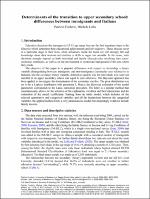Chapter Determinants of the transition to upper secondary school: differences between immigrants and Italians
Author(s)
Frederic, Patrizio
Lalla, Michele
Language
EnglishAbstract
The determinants of the transition from lower secondary to upper secondary school of Italian and immigrant teenagers (16-19 age range) were identified joining the European Union Statistics on Income and Living Conditions (EU-SILC) and the Italian Survey on Income and Living Conditions of Families with Immigrants in Italy (IM-SILC) for 2009. A set of individual, family, and contextual characteristics was selected through the Lasso method and a Bayesian approach to explain the choice of upper secondary schooling (yes/no). The transition from the low secondary to upper secondary school showed a complex pattern involving many variables: compared to men, women did not prove to have any differences, many components of income entered the model in a parabolic form, education level and income of parents proved to be very important, as was their occupation. The contextual factors revealed their importance: the latter included the degree of urbanisation, the South macro-region, household tenure status, the amount of optional technological equipment, and so on. Differences between Italians and immigrants disappeared when family background and parental characteristics were taken into account.
Keywords
Lower-to-upper; secondary transition; school-to-work; transition; educational inequality; parents’ effects on education; Lasso methodDOI
10.36253/978-88-5518-461-8.04ISBN
9788855184618, 9788855184618Publisher
Firenze University PressPublisher website
https://www.fupress.com/Publication date and place
Florence, 2021Series
Proceedings e report, 132Classification
Social research and statistics


 Download
Download Web Shop
Web Shop